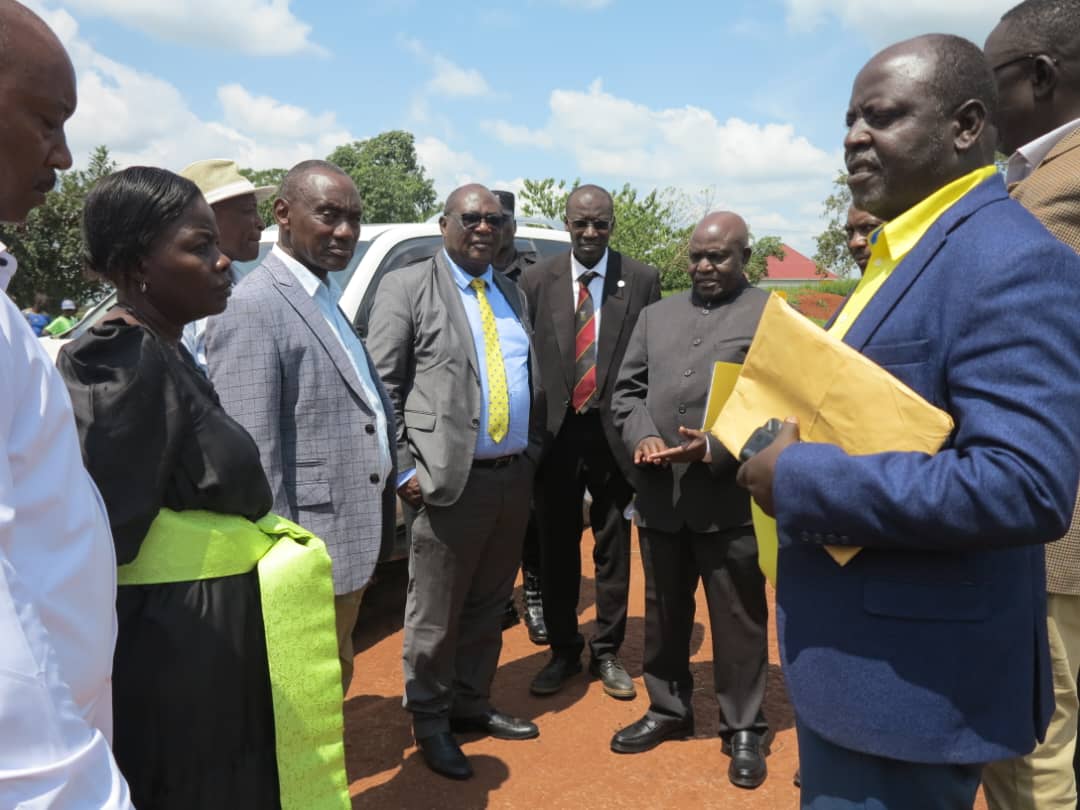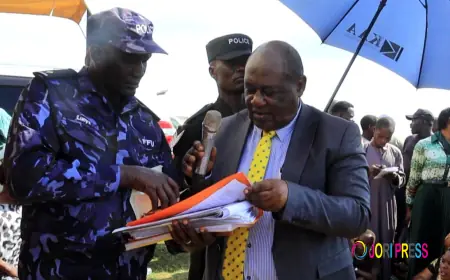Climate risks cloud Uganda’s high-income status ambitions


World Bank report says climate shocks could cut GDP growth by up to 3.1% unless urgent adaptation measures are taken
COVER STORY | RONALD MUSOKE | Uganda has set its economic development ambitions quite high. The country’s Vision 2040 blueprint lays out a bold goal: becoming an upper middle-income country where an average Ugandan’s annual income is about US$9500 (Approx. Shs 33 million). That is the government’s target over the next 15 years.
To get there, the economy must grow more than tenfold (US$500 billion), driven by oil, gas, tourism, digital services, logistics, and agro-industrialization. That will require average annual growth of 8.2%, a tall order, given that economic growth has averaged closer to 5% over the past decade.
But, as the government continues to chart the country’s development course, a new World Bank Country Climate and Development Report (CCDR) that was unveiled in Kampala on Sept.11 delivers a sobering warning: climate change could shatter all Uganda’s dreams. The report warns that unless urgent action is taken, climate shocks could shave off 3.1% of annual GDP growth by 2050, push hundreds of thousands of Ugandans into abject poverty, and force 12 million Ugandans into internal migration.
The report goes ahead to paint a stark picture of Uganda’s vulnerability but also outlines a roadmap for building a low-carbon, resilient economy. It argues that climate action, if embraced, can be a catalyst for faster, greener, and more inclusive development.
“Uganda faces a critical moment as the 14th most climate-vulnerable country,” said Qimiao Fan, the World Bank Division Director for Uganda, Kenya, Rwanda and Somalia. “Climate action is not only essential but offers an opportunity to redefine the country’s development trajectory.”
The findings were presented in Kampala by Diji Chandrasekharan Behr, the Lead Environmental Economist at the World Bank. “With the CCDR, we’re really aiming to look at the interplay between climate and development,” Behr explained. “This isn’t just about climate change or just about development, but how (the two) interact with each other.”
Climate Futures: A wet or dry Uganda
The report explores two possible futures for Uganda’s climate. In one, a wet, warm scenario, rainfall increases significantly, bringing widespread flooding. In the other, a hot, dry scenario, prolonged droughts dominate. Both threaten agriculture, health, infrastructure, and labour productivity.
Layered onto this are two economic scenarios: a business-as-usual trajectory, where urbanisation doubles and agriculture remains dominant. The aspirational path is where Uganda’s Vision 2040 becomes reality—growth surges to 8% annually, services expand, and Uganda’s urban population grows fivefold.
But neither path can escape the retarding force of climate change. “Higher growth can certainly reduce the impacts of climate change, but it does not eliminate them,” Behr cautioned. “Climate action over time is needed, and it can generate positive effects on GDP.” Without climate action, Uganda risks GDP losses of 3.1% under business-as-usual and 1.5% under an aspirational future.
Labour and health’s hidden costsThe CCDR identifies labour productivity losses as the single largest driver of economic decline. Rising temperatures will drain productivity across agriculture, services, and industry. Workers who mainly work in the open environment are especially vulnerable, the report warns.Behr said: “Moving people into occupations less exposed to heat will require sustained skilling, education reform, and tailored measures for women, who are disproportionately represented in high-exposure work.”
Diseases linked to rising temperatures and shifting rainfall will further undermine health and economic output. In addition,Uganda’s reliance on rain-fed agriculture leaves it acutely vulnerable. Already, year-to-year and even within-season rainfall fluctuations are making farming increasingly unpredictable. “Farmers are having to constantly adapt to variability, but it’s very hard to plan if you don’t know what’s coming,” Behr said.
But the report also points to hope: climate-smart agriculture and climate-compatible irrigation can not only reduce losses but boost productivity. The report notes that drought-tolerant seeds, soil management, improved livestock breeds, and carefully targeted irrigation could shift yields upward, though variability will remain. 
The report notes that the impacts of climate change will also not be felt evenly. Mapping reveals stark differences across the country’s regions. Areas such as Karamoja in northeastern Uganda, Acholi and Lango in the north, and Teso in the east are highly exposed to shocks and deeply vulnerable due to poverty and limited resilience. “These are the regions where targeted support programmes—healthcare, jobs, social protection—are most urgently needed,” Behr stressed.
Infrastructure at breaking point
The World Bank report also notes that Uganda’s infrastructure faces mounting climate stress. Roads are especially at risk with floods already accounting for 60% of damages. According to the report, road maintenance costs are projected to rise by US$14–26 million annually. By 2050, climate-related road delays could reach 3.5 million hours, crippling trade and logistics.
Uganda’s electricity sector, too, is exposed. The report notes that up to 11% of the transmission and distribution grid lies in high-risk flood and landslide zones. “While Uganda often discusses energy in terms of emissions, there’s also a clear case for adaptation and resilience,” Behr said.
Interestingly, urbanisation which is already accelerating is set to transform Uganda’s economic geography. By 2050, cities could absorb up to five times more people than today. But current municipal capacity lags far behind. “None of the municipalities in Greater Kampala have reached ideal conditions for governance, information, or climate planning,” Behr warned. Without stronger planning, floods and congestion could cripple productivity and deter private investment.”
The cost of inaction
The CCDR notes that Uganda’s labour productivity could drop by 2.4% due to a rise in temperatures, and that up to 21% of the electricity network could be exposed to extreme weather. The report notes that roads already cost the country an estimated US$26 million a year in climate-related damage, and worsening floods and droughts could multiply that toll.
For ordinary citizens, the numbers translate into lived hardships. Over the past two decades, an estimated 200,000 Ugandans have been affected annually by climate shocks–whether through destroyed crops, damaged infrastructure, or disrupted schooling.
“Our growth aspirations are vulnerable to climate change,” warned Maris Wanyera, the Director of Debt and Cash Policy at the Ministry of Finance, who spoke on behalf of Treasury Secretary Ramathan Ggoobi during the report launch. “If left unaddressed, climate change will undermine productivity, reduce competitiveness in global markets, and push more Ugandans into poverty,” Wanyera said. But the report notes that the risks extend beyond economics. Climate-induced migration could, for instance, displace up to 12 million people by 2050, overwhelming urban centres and straining public services.
Four pathways to climate-positive growth
The report models two possible economic futures. First is the “Business as Usual” where the country’s growth slows to around 6.5%, reforms stall, and the private sector remains weak. On the other hand is the “Aspirational Scenario” where growth reaches 8% thanks to reforms that boost manufacturing, services, agribusiness, and exports.
The World Bank report notes that both futures assume oil production will start soon, bringing revenues but also risks. The real difference will come from how seriously the country’s planners takes climate action. If emissions continue unchecked, Uganda’s carbon footprint could grow by as much as 90% by 2050,the report notes. But with reforms, the country could cut emissions while also creating jobs and building resilience.
Key areas for action
The World Bank outlines four broad packages of interventions to help Uganda stay on track. With one of the world’s youngest populations, Uganda’s future hinges on its youth. Yet most young people work in low-paying, climate-exposed jobs. Poor households cope with climate shocks by cutting back on essentials or migrating, often falling deeper into poverty.
The report calls for expanding social protection systems that provide timely support when disasters hit. It also highlights the need to align vocational training with private sector demand so young workers can shift into greener, more resilient jobs. Investments in health, water, sanitation, and climate-resilient schools are also critical.
By 2050, internal migration driven by climate change could affect 12 million Ugandans, particularly around the Lake Victoria Basin. Planning for that future must start now, the report notes. The report also recommedns climate-smart agriculture. As has been over the past decades, agriculture employs most Ugandans but is highly vulnerable. Crop yields could swing wildly, from gains of 12% to losses of the same scale, as climate pressures mount. Soil erosion and erratic rainfall will only add to the uncertainty.
The report says expanding irrigation, using drought-resistant seeds, improving soils, and promoting perennial crops and others could increase productivity by up to 220%. Livestock also needs attention. Heat stress and poor feed threaten 6.8 million farming households but better feed systems could boost cattle weights by 60% and reduce methane emissions by 40%.
Meanwhile, restoring wetlands and forests will be key. Uganda has lost 40% of its wetlands since the 1990s, largely to farming and urban growth. New incentives, from payments for ecosystem services to ecotourism, could encourage conservation.
The report recommends improvement in infastructure, including roads. The report also urges investment in climate-informed urban planning: resilient housing, electric public transport, better waste management, and clean energy systems. Here, private sector involvement has been cited as crucial, especially in areas like electric motorbikes, affordable housing, and sustainable transport.
The finance and policy challenge
Uganda has pledged to cut its Greenhouse gas (carbondioxide, methane) emissionsby nearly 25% by 2030. But turning pledges into action requires money—lots of it. The World Bank estimates Uganda will need between US$14 and US$76 billion in additional investment by 2050, depending on how ambitious its reforms are.
That money will need to come from a mix of sources: international climate funds, private sector loans, green bonds, and insurance schemes. Building a robust green finance market—complete with taxonomies, standards, and transparency—will be vital. So too will be convincing international partners to channel more adaptation finance in the form of grants. The government also needs to strengthen its institutions and that means making budgets climate-sensitive, improving data systems, and ensuring local governments are equipped to act. 
Oil: Opportunity or obstacle?
The report notes that Uganda’s 1.4 billion barrels of recoverable oil reserves are seen as a key driver of Vision 2040. But oil brings risks. To stay profitable, production costs must remain below US$30 per barrel, and global shifts toward renewable energy could leave assets stranded. Gas flaring and methane emissions also threaten Uganda’s environmental goals. The World Bank suggests Uganda diversify into renewables and energy transition minerals while ensuring transparent management of oil revenues.
The report notes that implementing Uganda’s updated Nationally Determined Contributions (climate action plan) will require an estimated US$28 billion by 2030 with two-thirds of that funding needed for adaptation, and one-third for mitigation.
The good news is that Uganda has already begun building its climate finance tools. It has established a Climate Finance Unit in the Ministry of Finance, Planning and Economic Development; issued a National Climate Finance Strategy; piloted climate budget tagging, and introduced a National Green Taxonomy to guide future investments.
But senior government officials admit the gap remains wide. “Current domestic resources are not enough,” Wanyera said. “We need strong partnerships leveraging concessional finance, mobilizing private capital, and accessing carbon markets and green bonds.”
The World Bank has committed nearly US$7.8 billion over the past decade to Uganda, with about US$2.2 billion of that tagged as climate co-benefits. This includes US$900 million for adaptation and US$1.3 billion for mitigation. The CCDR, World Bank officials stressed, will inform future lending strategies.
Private sector must step up
For the World Bank Group and its private sector arm, the International Finance Corporation (IFC), Uganda’s climate agenda cannot succeed without businesses on board. “Private investment in climate-smart agriculture, solar irrigation, renewable energy, e-mobility, and green building can enhance food security, energy access, and livable cities—while creating jobs and driving economic growth,” said Mary Porter Peschka, the IFC Division Director for Eastern Africa.
A narrow path forward
The CCDR is not just another climate study, officials stressed. Unlike past reports that focused solely on climate impacts, this one weaves climate into Uganda’s broader development fabric.
Annette Tamale Katuramu, the Acting World Bank Country Manager for Uganda said Uganda is already moving ahead with reforms, from preparing its third iteration of NDCs to mainstreaming climate disaster risk screening of public investments. But she warned that the window for decisive action is narrowing. “Ugandans know climate change is not a concern for the future, but one that needs to be tackled today—and collectively,” she said.
The World Bank’s message is blunt: Uganda cannot achieve its Vision 2040 unless climate action is built into every sector. The costs of inaction are steep. But the benefits of action—resilient infrastructure, sustainable cities, thriving farms, and better jobs—are within reach.
While concluding her presentation of the report, Behr, the World Bank consultant, offered four messages for Uganda. “Act now, act together, ensure that you act in a way that brings your human capital, your natural capital, and your physical capital forward in a climate resilient way, and lastly, ensure that the private sector is an active partner in the work that you’re doing on climate change,” she said. 
Uganda responds to WB with climate finance push
Meanwhile, the government of Uganda has welcomed the World Bank’s Country Climate and Development Report (CCDR), describing it as a crucial roadmap for integrating climate action into Uganda’s economic development.
Dennis Mugagga, the head of the Climate Finance Unit at the Ministry of Finance, Planning and Economic Development, emphasised the urgent need for coordinated efforts, noting that “if we continue with business as usual, Uganda risks losing up to 70% of its GDP by 2050. Even if we achieve our tenfold growth ambitions by 2040, inaction on climate could still cost us 30 percent of GDP.”
Coinciding with the World Bank Country Climate and Development Report launch, the government also launched several climate finance tools aimed at mobilising resources, strengthening institutions, and engaging the private sector in climate action. Central among these is the National Climate Finance Strategy, which seeks to raise US$ 4.1 billion annually to support climate-resilient development while reducing national emissions by 24.7%.
Mugagga explained that the strategy is “not just about raising money—it’s about mobilising it efficiently, tracking its use, and ensuring it aligns with Uganda’s development ambitions under Vision 2040 and the National Development Plan IV.”
Another milestone is the National Green Taxonomy, which provides a clear classification of climate-positive activities across the country’s economic sectors. This framework is intended to guide private sector investments in projects that mitigate climate change, promote adaptation, conserve resources, and create sustainable livelihoods. Mugagga noted that it “offers a roadmap for investors to participate in Uganda’s green agenda and helps us meet international commitments under the Paris Agreement and the Sustainable Development Goals.”
The government has also issued guidelines for mainstreaming climate action in the financial sector, recognising the sector as a critical enabler for climate-resilient development. These guidelines aim to build capacity, raise awareness, and ensure banks, insurance firms, and other financial institutions integrate climate risks and opportunities into their planning. “Climate change affects not only the environment but also the financial health of businesses and communities. Our financial sector must lead the way in responding to these challenges,” Mugagga explained.
A key instrument in this strategy is the National Climate Financing Vehicle, designed to mobilise and channel resources from both domestic and international sources. Housed within the Ministry of Finance, it will operate on a results-based approach to ensure transparency, accountability, and alignment with national priorities. Mugagga emphasised that it will “leverage both public and private sector funds and strengthen Uganda’s participation in global climate finance mechanisms such as the Green Climate Fund and emerging carbon markets.”
The government’s response underscores a central message that climate action is inseparable from development. Investments in resilient infrastructure, sustainable agriculture, and human capital are not only necessary for economic growth but also for safeguarding livelihoods across the country. As Mugagga concluded, “We must act now, and we must act together—building a climate-resilient Uganda is not an option; it is a necessity for our future.”






























































